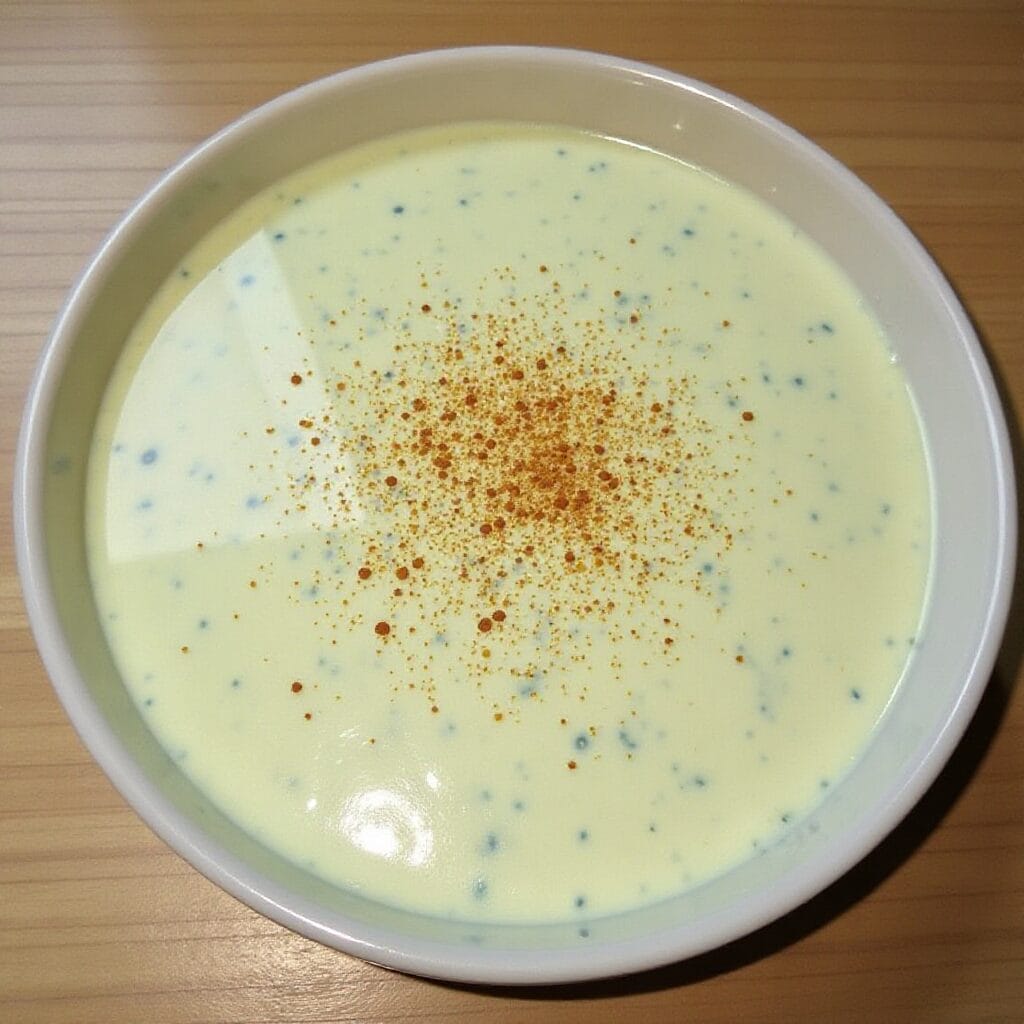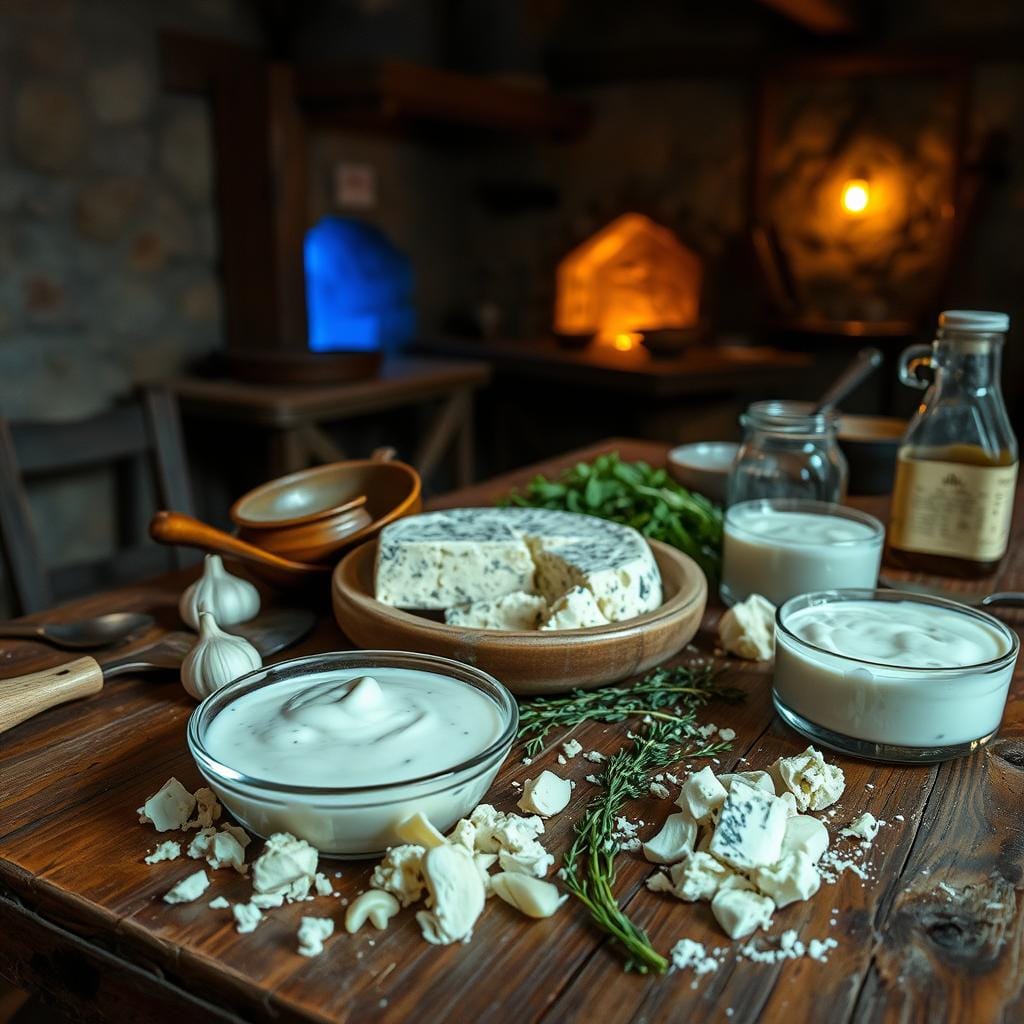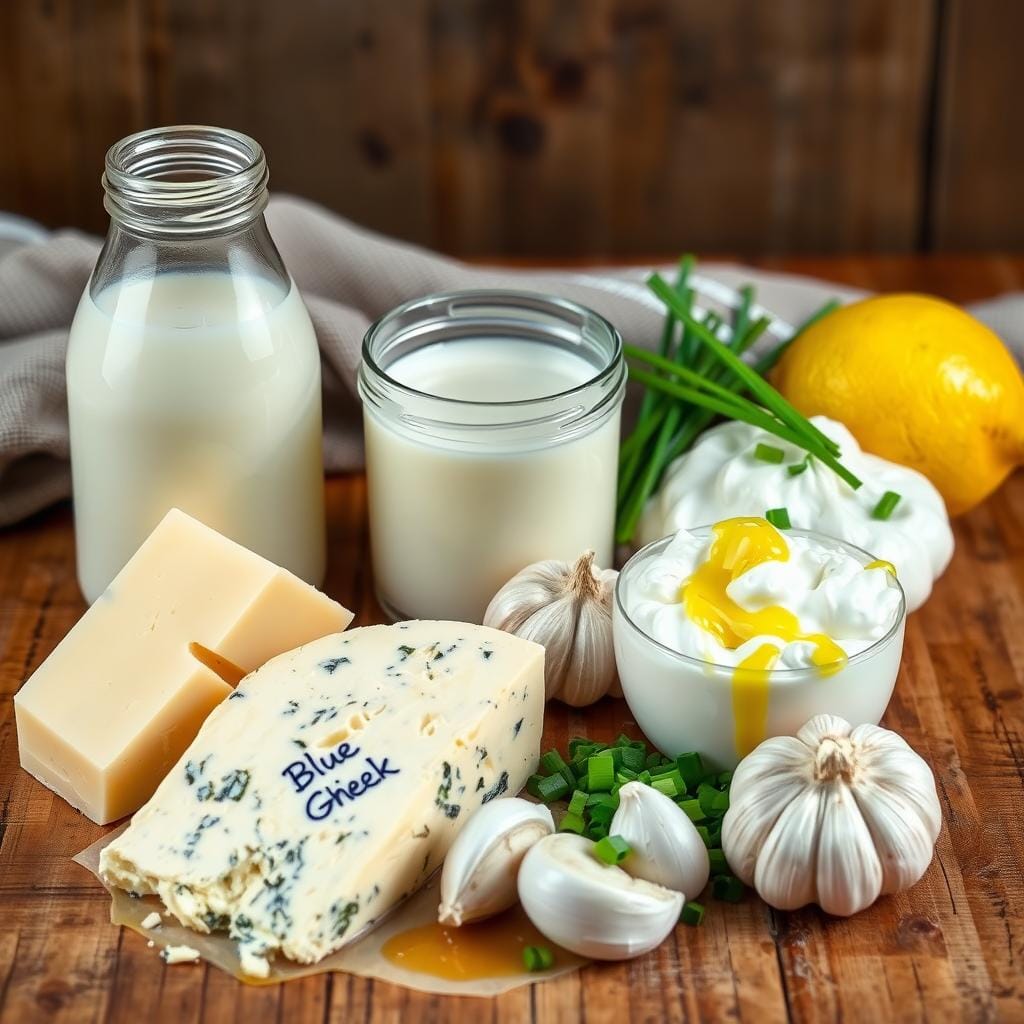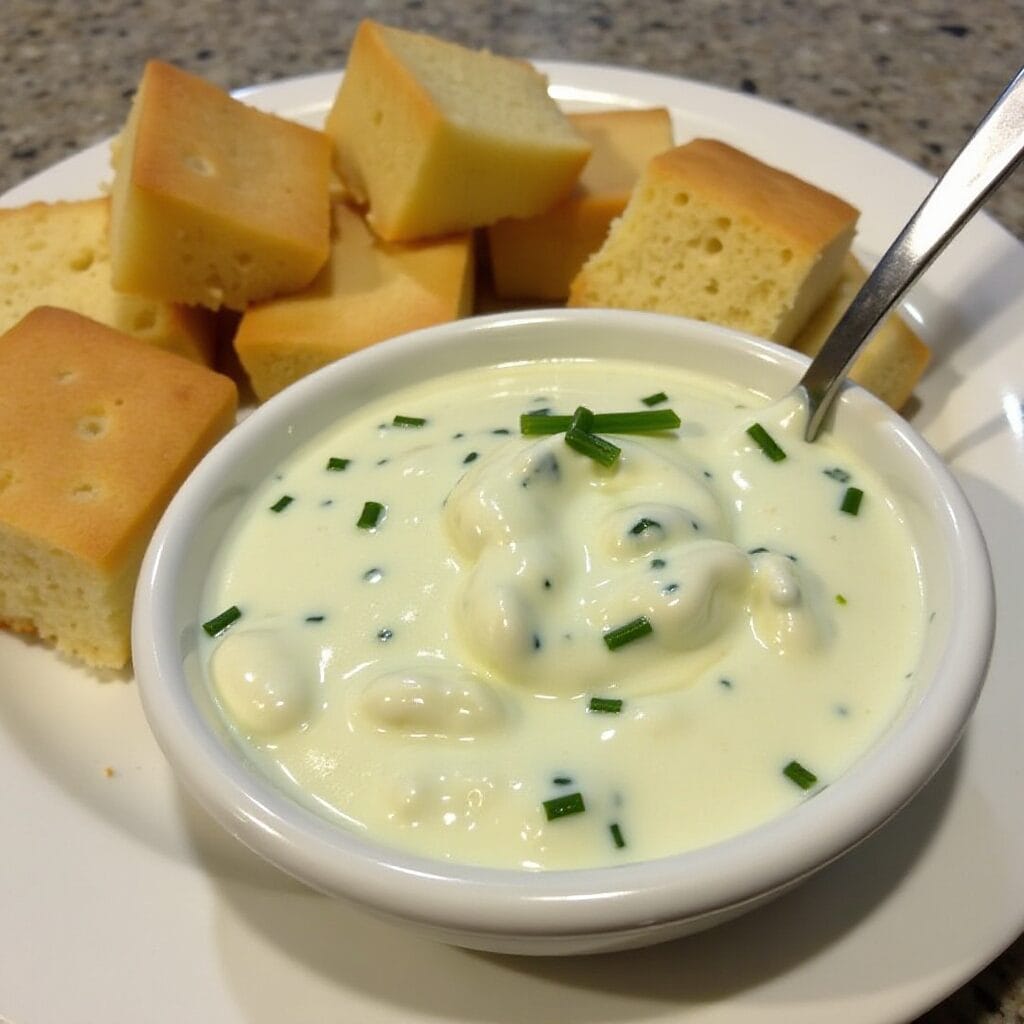Ever enjoyed the rich taste of blue cheese dressing with your salad or veggies? It’s a favorite for many, thanks to its creamy and bold flavors. This guide will take you into the world of blue cheese dressing. We’ll explore its history, key ingredients, and how to make it at home.

Key Takeaways
- Discover the French connection to the origins of blue cheese dressing
- Learn about the core ingredients that make up traditional blue cheese dressing
- Understand the importance of quality ingredients and proper ratios for the perfect consistency
- Explore various types of blue cheese that work best for creating a flavorful dressing
- Uncover the step-by-step technique for mixing a smooth, creamy blue cheese dressing at home
This guide is for both seasoned chefs and beginners. It will help you improve your blue cheese dressing skills. You’ll learn how to make a dressing that will excite your taste buds and wow your guests.
Explore the Secrets Behind Cream Cheese
Let’s start this tasty journey. We’ll uncover the story of blue cheese dressing and how to make it in your kitchen.
Understanding Blue Cheese Dressing’s History and Origins
Blue cheese dressing has a rich history that spans continents and cuisines. It comes from the flavorful blue cheeses made in France for centuries. These cheeses are known for their blue veining and bold, tangy taste.
The French Connection to Blue Cheese
The history of blue cheese starts in France’s Roquefort region. Cheesemakers there have made Roquefort cheese for over a thousand years. This cheese is creamy, pungent, and a key part of French cuisine.
Evolution into American Cuisine
In America, blue cheese dressing became a favorite in salads and as a dip. Its creamy texture and tangy flavor pair well with greens, veggies, and even burgers and wings. Today, it’s a common ingredient in American kitchens and restaurants.

“Blue cheese dressing has become an integral part of American culinary culture, bridging the gap between French gastronomic traditions and American ingenuity.”
Essential Ingredients for Traditional Blue Cheese Dressing
To make a real blue cheese dressing, you need to know the key ingredients. These include rich dairy products and aromatic seasonings. Each part is crucial for the dressing’s flavor and texture.
The base of blue cheese dressing is mayonnaise and sour cream. They make it creamy and balance the blue cheese’s bold taste. You can adjust how much of each you use to get the perfect creaminess and tanginess.
The blue cheese is the main ingredient. The type you pick affects the dressing’s flavor. You can choose from milder Gorgonzola to stronger Roquefort. Getting the right amount of blue cheese is key for a good balance.
Traditional blue cheese dressing also has herbs and seasonings. These include garlic, Worcestershire sauce, lemon juice, and black pepper. They add to the flavor and make the taste more complete.
| Ingredient | Purpose |
|---|---|
| Mayonnaise | Provides a creamy base |
| Sour Cream | Adds tanginess and richness |
| Blue Cheese | Lends the signature flavor |
| Garlic | Enhances the overall aroma and taste |
| Worcestershire Sauce | Adds depth and savory notes |
| Lemon Juice | Balances the richness with a touch of acidity |
| Black Pepper | Provides a subtle heat and complexity |
With these ingredients and the right mix, you can make a traditional blue cheese dressing. It will taste great and impress everyone.

What is Blue Cheese Dressing Made Of?
Making the perfect blue cheese dressing means knowing its main parts. It’s a mix of top-notch ingredients that give it its unique taste and feel.
Core Components Breakdown
The main parts of blue cheese dressing are:
- Crumbled blue cheese, giving it a strong, salty taste
- Mayonnaise or sour cream, making it creamy
- Vinegar or lemon juice, adding a tangy kick
- Herbs and spices like garlic, onion, and black pepper, to boost the flavor
Quality of Ingredients Matter
The quality of what goes into blue cheese dressing is key. Choose the best blue cheese and fresh herbs and spices. This will make your blue cheese flavor pop and your dressing creamy and delicious.
Optional Additions and Variations
You can also add things to make your blue cheese dressing your own. Some great options include:
- Minced onion or shallot for a hint of sweetness
- Worcestershire sauce or Dijon mustard for a deeper flavor
- Buttermilk or yogurt for a tangier, thicker dressing
- Fresh herbs like chives, parsley, or dill for a fresh taste
Knowing the basics of blue cheese dressing and the importance of quality ingredients lets you make a homemade version that hits the spot.
Types of Blue Cheese Best Suited for Dressing
Choosing the right blue cheese is crucial for a great blue cheese dressing. Each type has its own taste, from tangy to creamy. Exploring these varieties helps you find the perfect match for your dishes.
Roquefort is a classic choice, known for its bold flavor. Gorgonzola, from Italy, is creamier and milder. Stilton, from Britain, has a complex taste with nutty notes.
Want to try something different? Gorgonzola dolce is sweeter and creamier. For a unique American taste, try Rogue River Blue or Crater Lake Blue.
| Blue Cheese Variety | Origin | Flavor Profile | Dressing Suitability |
|---|---|---|---|
| Roquefort | France | Bold, pungent | Adds depth and complexity |
| Gorgonzola | Italy | Creamy, mild | Pairs well with a variety of ingredients |
| Stilton | United Kingdom | Complex, nutty | Versatile for many dressing applications |
| Gorgonzola dolce | Italy | Sweet, delicate | Lends creaminess to dressing |
| Rogue River Blue | United States (Pacific Northwest) | Tangy, crumbly | Distinctive American twist on blue cheese dressing |
The best blue cheese for your dressing depends on your taste. Try different types to find the one that enhances your dressing. This will make your homemade blue cheese dressing stand out.
“The right blue cheese can transform a simple salad dressing into a culinary masterpiece.”
The Base Components: Mayonnaise and Sour Cream
Mayonnaise and sour cream are key to making great blue cheese dressing. They mix to give the dressing its creamy texture and tangy taste. This mix is what makes the dressing so loved.
Proper Ratios for Perfect Consistency
Finding the right mix of mayonnaise and sour cream is important. A good rule is to use twice as much mayonnaise as sour cream. This makes the base creamy and ready for blue cheese and other flavors.
For example, use 1 cup of mayonnaise with 1/2 cup of sour cream. This mix keeps the dressing smooth and easy to pour. You can tweak the amounts to make it creamier or thinner, based on what you like.
Substitution Options
If you want to avoid dairy or eat less fat, there are other choices. Plant-based yogurt or Greek-style dairy-free yogurt can replace sour cream. Avocado or vegan mayonnaise can also be used instead of regular mayonnaise. These options let you enjoy blue cheese dressing while following your dietary needs.
| Ingredient | Traditional Ratio | Substitution Ratio |
|---|---|---|
| Mayonnaise | 2 parts | 2 parts |
| Sour Cream | 1 part | 1 part plant-based or dairy-free yogurt |
Knowing the main ingredients and their best ratios helps you make a great blue cheese dressing. You can stick with traditional dairy or try plant-based options. Either way, you’ll get a dressing that’s creamy and full of flavor.
Herbs and Seasonings That Enhance the Flavor
Creating the perfect blue cheese dressing is all about the herbs and seasonings. The right mix can take your dressing from good to great. Try adding caraway seeds for an earthy taste or fresh chives for a bright, herbaceous flavor.
Parsley is a common choice for blue cheese dressing. It adds a fresh, peppery taste that balances the dressing’s richness. Dill is another favorite, bringing a subtle sweetness that cuts through the blue cheese’s boldness.
- Garlic powder or minced fresh garlic can add depth and savory notes.
- A sprinkle of black pepper enhances the overall seasoning.
- Fresh chives or green onions offer a delicate onion-like flavor and a pop of color.
- Caraway seeds lend an earthy, nutty undertone that pairs beautifully with the blue cheese.
When adding herbs and seasonings, start small and adjust to taste. The goal is to enhance the blue cheese without overpowering it. A well-balanced mix is key to a delicious dressing.
| Herb/Seasoning | Flavor Profile | Recommended Usage |
|---|---|---|
| Parsley | Fresh, slightly peppery | 1-2 tablespoons, chopped |
| Dill | Subtle sweetness | 1 teaspoon, chopped |
| Garlic | Savory, pungent | 1/2 teaspoon, minced or powder |
| Black Pepper | Spicy, aromatic | 1/4 teaspoon, or to taste |
| Chives | Delicate onion flavor | 1 tablespoon, chopped |
| Caraway Seeds | Earthy, nutty | 1/2 teaspoon |
By choosing the right herbs and seasonings, you can make a blue cheese dressing that’s both complex and irresistible.
“The right herbs and seasonings can transform a good blue cheese dressing into something truly memorable.”
Step-by-Step Mixing Technique for Smooth Results
Making creamy, smooth blue cheese dressing at home is simple. Just follow a few easy steps and use the right tools. You’ll get restaurant-quality results in your kitchen. Let’s explore the steps to perfect your blue cheese dressing.
Equipment Needed
You’ll need a few basic tools to start:
- A large mixing bowl
- A whisk or hand mixer
- A rubber spatula
- Measuring cups and spoons
These tools will help you mix the ingredients smoothly.
Proper Storage Methods
After making your blue cheese dressing, store it right to keep it fresh. Put it in an airtight container, like a glass jar or sealed plastic. Keep it in the fridge for up to 5 days. This lets the flavors get even better.
When you’re ready to serve, just stir it gently. This helps mix any parts that might have separated.
By mixing and storing your blue cheese dressing the right way, you’ll enjoy it every time. Use it on salads, with veggies, or as a topping for burgers. Make your meals better with homemade blue cheese dressing.
Common Problems and Troubleshooting Tips
Making homemade blue cheese dressing can be fun, but it comes with its own set of challenges. You might face dressing consistency issues or need to adjust the flavors. But don’t worry, with the right blue cheese dressing tips, you can fix these problems and get the dressing just right.
One common problem is a dressing that’s too thick or too thin. If it’s too thick, whisk in some milk or buttermilk to thin it. If it’s too thin, add a bit more mayonnaise or sour cream to thicken it.
Another issue is flavor imbalance. If the dressing tastes flat, try adding lemon juice, garlic powder, or more blue cheese. The goal is to find the perfect mix of tangy, savory, and creamy.
“The key to great blue cheese dressing is finding the right harmony between the cheese, the creamy base, and the seasonings.”
With patience and a bit of experimentation, you can solve any dressing consistency issues or flavor adjustments. Just remember these blue cheese dressing tips and you’ll be on your way to making a fantastic homemade blue cheese dressing.
Health Considerations and Nutritional Information
Blue cheese dressing can be a tasty addition to many dishes. But, it’s key to watch your portion sizes and consider dietary needs. This creamy condiment is great on salads, but it’s important to be mindful of how much you eat.
Caloric Content and Serving Sizes
Blue cheese dressing is high in calories. A 2-tablespoon serving has about 150-200 calories. The fat from blue cheese and mayonnaise or sour cream makes it calorie-dense. It’s crucial to control your serving sizes to meet your dietary goals.
Dietary Restrictions and Alternatives
For those on low-fat or low-calorie diets, or with lactose intolerance, blue cheese dressing can be a challenge. But, there are healthy alternatives that can meet your cravings and fit your dietary needs.
- Choose a reduced-fat or non-fat blue cheese dressing to lower calories and fat.
- Go for a dairy-free, plant-based dressing with Greek yogurt, avocado, or cashews for a creamy texture without lactose.
- Make your own dressing with blue cheese crumbles, olive oil, and vinegar for a healthier, customizable option.
| Nutritional Comparison | Regular Blue Cheese Dressing | Healthy Alternative |
|---|---|---|
| Calories (per 2 tbsp) | 150-200 | 80-100 |
| Total Fat (per 2 tbsp) | 15-20g | 5-10g |
| Saturated Fat (per 2 tbsp) | 4-6g | 1-2g |
| Cholesterol (per 2 tbsp) | 15-20mg | 5-10mg |
Knowing the nutritional facts of blue cheese dressing and trying healthy alternatives lets you enjoy its flavor while keeping your diet balanced. This way, you can meet your blue cheese dressing nutrition and dietary restrictions needs.
Serving Suggestions and Pairing Ideas
Blue cheese dressing is more than just for salads. It’s a versatile condiment that can enhance many dishes. Try these creative ideas to make your meals more exciting.
Dip Into It
Blue cheese dip is loved by all. It’s great with fresh veggies, chips, or bread. It’s a hit at parties, offering a tasty snack that everyone wants more of.
Dress Up Your Dishes
Blue cheese dressing can transform any dish. It’s amazing on grilled meats, roasted potatoes, and pasta. Mix it with other flavors to create your favorite dish.
Refresh with a Salad
Blue cheese dressing is a classic salad choice. Mix it with greens, tomatoes, and croutons for a delicious meal. You can also use it as a dip for a unique salad twist.
| Food Pairing | Flavor Profile |
|---|---|
| Steak | The bold, savory flavors of blue cheese dressing complement the rich, grilled steak perfectly. |
| Buffalo Chicken | The cool, creamy dressing balances the heat of spicy buffalo sauce, creating a harmonious flavor combination. |
| Roasted Vegetables | The tangy dressing adds a delightful contrast to the natural sweetness of roasted veggies. |
Blue cheese dressing is a versatile ingredient. It can change your meals in exciting ways. Whether you’re dipping, dressing, or drizzling, it’s a must-try for any food lover.
Homemade vs. Store-Bought Comparison
Choosing between homemade and store-bought blue cheese dressing is a big decision. Each option has its own pros and cons. Knowing these differences helps you decide what’s best for you.
Making homemade blue cheese dressing lets you pick the best ingredients. You can use top-notch blue cheese and fresh herbs. Plus, you can tweak the flavors to match your taste. Making it yourself can also save money over time, especially if you make a lot at once.
Store-bought dressings are quick and easy to use. They’re perfect when you’re in a hurry or don’t feel like making it. Many brands offer a consistent taste, so you know what to expect every time.
| Homemade Blue Cheese Dressing | Store-Bought Blue Cheese Dressing |
|---|---|
| Allows for customization of ingredients and flavors | Convenient and readily available |
| More cost-effective in the long run | Consistent flavor profile |
| Fresher and higher-quality ingredients | Longer shelf life |
| Time-consuming to prepare | May contain preservatives or additives |
Whether to go for homemade or store-bought blue cheese dressing depends on what you prefer. It also depends on how much time you have and what you’re making. Both options have their good points, so it’s worth trying both to see which one you like best.
Conclusion
Blue cheese dressing is a tasty and versatile condiment. It has a rich history and many uses. You can make it creamy or chunky, depending on your taste.
Start with good ingredients like mayonnaise and sour cream. Add herbs and seasonings to boost the flavor. Making your own blue cheese dressing is rewarding.
It lets you create a version that fits your taste and diet. So, why not try making it? Mix different blue cheeses and adjust the ingredients. Serve it with veggies, on salads, or as a dip.
Homemade blue cheese dressing will make your meals better. It will leave you wanting more.

